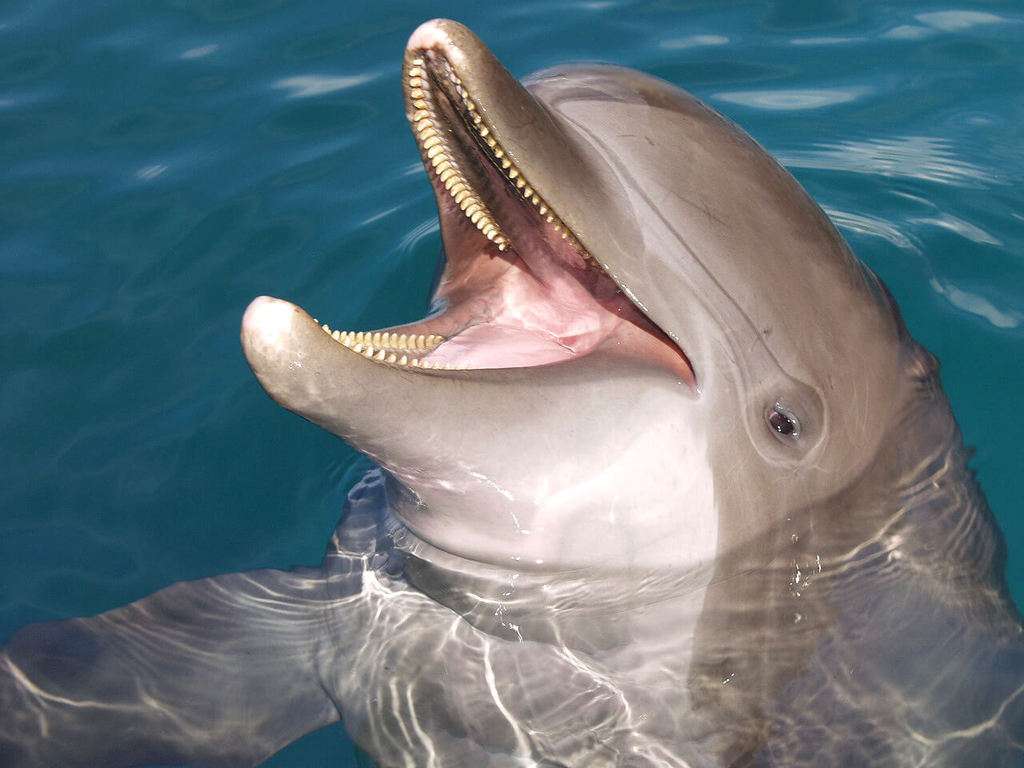Do Dolphins Have Sharp Teeth

Dolphin teeth sharpness
Introduction
Dolphins, often regarded as some of the most intelligent and fascinating creatures in the oceans, captivate our imaginations with their graceful movements and playful antics. Yet, beneath their friendly demeanor lies a set of remarkable tools that have helped them survive and thrive in the world’s vast waters for millions of years: sharp teeth.
Dolphins are renowned for their sleek bodies, streamlined for efficient swimming, and their characteristic dorsal fins. However, it’s their teeth that play a crucial role in their daily lives. These marine mammals boast a set of impressive, razor-sharp teeth, designed for far more than just a captivating smile.
Dolphins teeth, its purpose in their survival strategies, and the unique adaptations that make these teeth remarkable tools for hunting, defence, and communication. Join us on this voyage into the watery realms of these charismatic creatures to unravel the mysteries of their sharp teeth and the pivotal role they play in the lives of dolphins.

Are dolphins’ teeth sharper than sharks?
Dolphins have up to 268 sharp teeth used to tear flesh from their prey, but their bite power is very low compared to other prey. Sharks have a much more powerful bite and far deadlier teeth than dolphins.
They primarily feed on fish and squid, so their teeth are adapted for holding onto slippery prey. In contrast, sharks have razor-sharp, serrated teeth that are ideal for cutting through flesh and bone. These teeth are suited for a diet of larger marine animals, such as seals and fish. So, while both dolphins and sharks have sharp teeth, the sharpness and purpose of their teeth vary based on their diets and hunting strategies.
Do dolphins have pointy teeth?
A dolphin’s teeth are typically conical and pointed. They are a regular size and shape, unlike ours. While many animals have teeth for biting or grinding, a dolphin’s teeth are just designed for grabbing slippery fish and making sure they don’t get away.
Dolphins use these sharp teeth for capturing and gripping their prey, which typically consists of fish and other marine creatures. Their teeth are not as serrated or designed for cutting through flesh like those of sharks but are well-suited for grasping and holding onto slippery prey. Additionally, the continual replacement of teeth ensures that dolphins maintain the sharpness needed for their hunting and survival in the aquatic environment.
How sharp are a dolphin’s teeth?
The dolphin’s sole tooth type is small (up to ½ inch in length) and conical. Depending on the species of dolphin, these teeth may be blunt or sharp–it all depends on what they like to eat.
A dolphin’s teeth are indeed sharp, though not as razor-sharp as those of some other predators like sharks. Dolphin teeth are conical in shape and possess a keen edge, enabling them to grasp and grip prey effectively. These teeth are designed for hunting fish and other marine creatures, helping dolphins tear apart their prey into manageable pieces.
The sharpness of their teeth is crucial for their survival, as it ensures their ability to capture and consume prey efficiently. Additionally, the continual replacement of teeth throughout their lives helps maintain their sharpness, allowing them to remain formidable hunters in the aquatic world.
Do dolphins have flat teeth?
Dolphins tend to have prominent, elongated “beaks” and cone-shaped teeth, while porpoises have smaller mouths and spade-shaped teeth. Dolphins possess conical-shaped teeth that are sharp and pointed. These teeth are specifically adapted for grasping and gripping prey, such as fish and squid.
Unlike animals with flat molars for grinding plant matter, dolphins are carnivorous marine mammals, and their teeth are designed for catching and tearing apart their prey. Their teeth continually grow and are replaced throughout their lives to ensure they remain sharp and effective for hunting. This unique dental adaptation is crucial to their survival as apex predators in the ocean’s ecosystems.
Are dolphins friendly to humans?
We encourage you to observe them from a distance of at least 50 yards (150 feet) for the following reasons: Dolphins have a reputation for being friendly, but they are actually wild animals who should be treated with caution and respect. Interactions with people change dolphin behavior for the worse.
Dolphins are generally known for their friendly and curious nature towards humans. Many encounters between dolphins and people have showcased their playful behavior, often approaching boats, surfers, or swimmers. These interactions have fostered a perception of dolphins as friendly sea creatures. In some instances, dolphins have even been credited with rescuing distressed swimmers. However, it’s essential to remember that dolphins are wild animals, and their behavior can vary.
Do all species of dolphins have sharp teeth?
No, not all species of dolphins have sharp teeth. While most dolphins possess sharp teeth suited for hunting and catching prey, there are exceptions. For instance, the Indian River dolphin has teeth that are less sharp, as its primary diet consists of small fish and crustaceans rather than larger prey
This variation in dental morphology corresponds to their specific dietary preferences. Dolphins with blunter teeth typically feed on smaller fish and crustaceans, whereas those with sharper teeth are better equipped for capturing larger prey. So, the shape and sharpness of a dolphin’s teeth are closely tied to its diet and ecological niche within the complex marine ecosystem.
How do dolphins keep their teeth sharp?
Dolphins maintain sharp teeth through constant use and natural replacement. As they hunt and feed on prey, their teeth naturally wear down, but they continuously grow new ones throughout their lives. This process helps ensure that they always have sharp teeth for hunting.
Dolphins maintain sharp teeth through a combination of factors. Their diet plays a significant role as they primarily consume fish and other aquatic prey with tough, abrasive components like scales and bones. Chewing on these natural, textured foods helps to naturally file down their teeth.
Are dolphin teeth as sharp as those of sharks?
Dolphin teeth are sharp but not as razor-sharp as those of sharks. Shark teeth are typically serrated and designed for cutting through flesh and bone, while dolphin teeth are more conical in shape and better suited for grasping and gripping prey.
Dolphin teeth are not as sharp as those of sharks. While both animals have teeth adapted for hunting, their dental structures serve different purposes. Shark teeth are razor-sharp and serrated, designed for tearing through flesh and bone. In contrast, dolphin teeth are more conical and pointed, better suited for grasping and gripping prey. Dolphins use their teeth to catch and secure fish and other small aquatic creatures, relying more on their speed and agility in the hunt.
Can dolphins use their teeth for communication?
Yes, dolphins use their teeth as part of their communication repertoire. They may make clicking sounds by rapidly closing their mouths, which can serve various purposes, including echolocation for navigation and communication with other dolphins.
Dolphins are indeed capable of using their teeth for communication, although their primary means of communication involve a diverse range of vocalizations, body language, and gestures. Their teeth play a role in a specific form of communication known as echolocation. By emitting clicking sounds through the rapid closure of their jaws, dolphins create high-frequency sound waves that bounce off objects in their environment.
Are there any dental health issues that dolphins face?
Dolphins, like other animals, can experience dental health issues such as tooth decay, infections, or injuries. These problems can be caused by various factors, including diet, environmental pollutants, or physical trauma. In some cases, dental issues can impact a dolphin’s ability to hunt and feed effectively, which can be life-threatening in the wild.
Dental problems can arise due to various factors, including diet, environmental pollutants, or physical trauma. In captive dolphins, dental issues are more prevalent, often attributed to a less varied diet and the stresses of captivity. Dental health is crucial for their survival, as damaged or infected teeth can hinder their ability to hunt and feed effectively. Therefore, efforts are made by marine biologists and veterinarians to address and mitigate dental health concerns in both wild and captive dolphin populations.

Conclusion
Dolphins’ sharp teeth serve as multifunctional tools that contribute significantly to their survival in the often challenging marine environment. These teeth are not merely for show; they are precision instruments designed for hunting and capturing prey, defending against potential threats, and even facilitating social interactions through communication.
Furthermore, we have delved into the adaptations that make these teeth remarkable, such as their conical shape, keen edge, and continual replacement—a testament to nature’s impeccable design. These adaptations are essential for the dolphins’ success as apex predators and integral members of their aquatic ecosystems.
Our exploration of dolphins’ sharp teeth has illuminated the intricate web of life beneath the ocean’s surface, where form and function blend seamlessly to create one of nature’s most extraordinary creatures. As we marvel at these graceful beings, let us continue to cherish and protect the oceans and the incredible life they harbor, including the sharp-toothed wonders we call dolphins.



